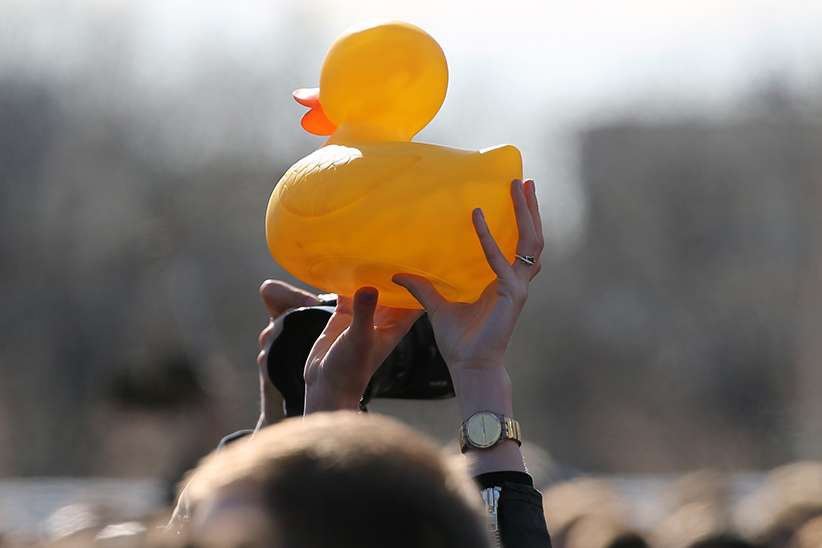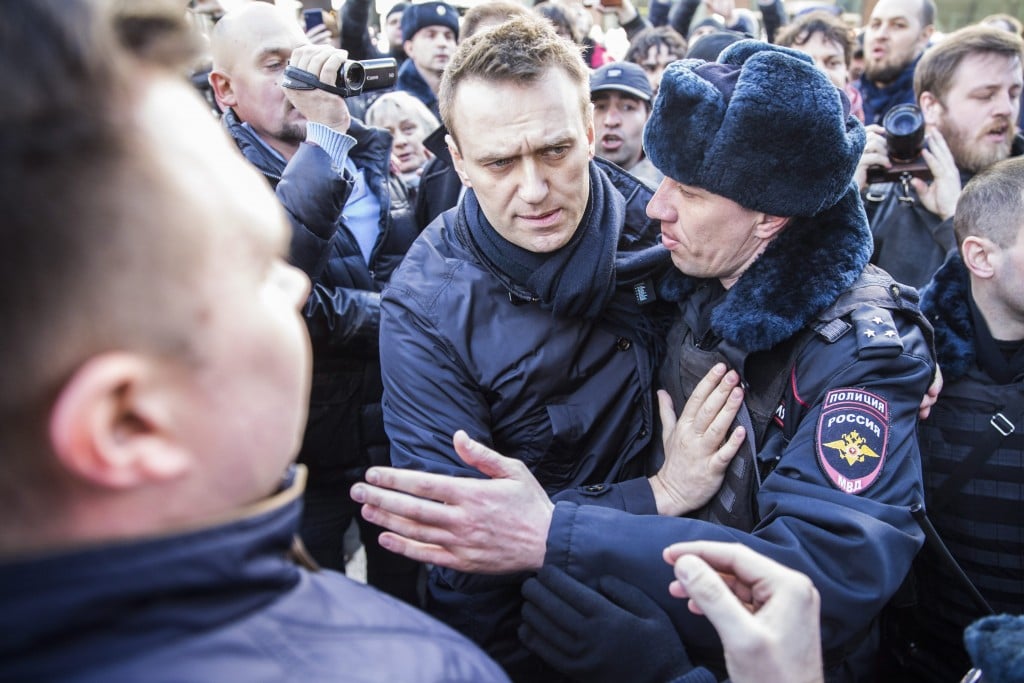What Russia’s protests say about the rise of its independent media
With thousands-strong demonstrations, youth are mobilizing in Russia—all proof of a vital shift in how they consume information
MOSCOW, RUSSIA – MARCH 26, 2017: A yellow rubber duck during Russian opposition activist Alexei Navalny’s anti-corruption rally in Pushkin Square. The event has not been authorized by the Moscow Government. Dmitry Serebryakov/TASS (Photo by Dmitry SerebryakovGetty Images)
Share

Youth flooded the streets in Russia on March 26, wielding yellow rubber ducks and sneakers as they protested government corruption. But despite thousands of participants across the country, neither of those anti-corruption symbols graced the country’s television channels. Programming continued as scheduled, providing the perfect illustration for a growing trend: As Russia wages information wars at home and abroad, its youth are mobilizing—and they’re doing so thanks to the rise of independent media.
Mainstream media in Russia is strictly government-controlled. Television channels didn’t mention the protests while they were happening, and websites of major newspapers were nearly universally silent. The infamous Sputnik agency and RT either didn’t have the stories at all or buried them under a pile of other content. While people in more than 90 cities chanted in unison against government corruption, most news broadcasts led with a story about Ukraine not allowing a Russian Eurovision contestant to attend. In the wake of the protests, television channels even cut some of the speeches at Russia’s Nika Film Awards if they mentioned the protests.
But that wasn’t the case with independent media. In the face of government message control, new online publications and independent-minded people harnessing the internet have taken it upon themselves to cover all news, not just what’s convenient for the government—and that’s what Russia’s young people are reading.
LONGREAD: Does Putin mark the return of the czar?
Hence, those ducks and shoes. They are specific references to corruption allegations against former president and current prime minister Dmitry Medvedev published online by opposition politician Alexei Navalny and his team. The duck represents an investigation which revealed that Medvedev has a house built specifically for a duck on one of his properties. The sneakers are what inspired the latest investigation: They refer to Medvedev’s online shopping, with reports saying he bought 73 t-shirts and 20 pairs of sneakers in three months, the receipts of which were used to verify the president’s email archives published by Wikileaks. The investigation into Medvedev was released online—including in a YouTube video with over 17 million views—and mobilized Russians. Those symbols are proof that people are paying attention to an investigation that would never have been shown on television.

Navalny is walking evidence that Russia’s youth are getting their information in places beyond state-run TV. When he began his political career, the 40-year-old lawyer targeted young people online by writing against corruption on LiveJournal, which remains a very popular blogging platform in Russia. “His use of social media to deliver his message symbolizes his political style, reaching out to predominantly young followers in sharp, punchy language, mocking the establishment loyal to President Putin,” the BBC wrote of Navalny, who has become so successful he recently announced his candidacy for Russia’s presidency. Before the protests, schoolchildren were even making YouTube videos in support of him and the mobilization.
Of course, most protests are made up of young people, and not just in Russia. But they also reflect the changing media diet in the country. Even in North America the television audience is aging and, according to 2015 research, that’s the case in Russia as well. However, the fact that the ascendant 18-to-35-year-old generation is slowly veering away from TV means more in Russia, where that medium happens to also be where government propaganda is most prominent.
While the majority of Russia’s mainstream media have deflected or remained silent on the growing dissent, independent outlets sunk their teeth into fearless reporting. Novaya Gazeta (New Newspaper) broke the story of gay men being disappeared and tortured in Chechen. Dozjd (TV Rain) published an in-depth look at a very expensive private jet likely owned by the head of the Chechen Republic, Ramzan Kadyrov. RBC figured out that Russia’s infamous troll farm likely morphed into a fake news farm. Meduza takes a no-nonsense look at daily goings-on. The Moscow Times both amplifies Russian news for English speakers and conducts its own investigations. And those independent outlets are just the tip of the iceberg; there are many local publications doing similarly impactful work.
There’s no telling how youth participation will change the political climate in Russia, but it’s fair to say it gave authorities a scare. After the protests, there have been reports of students getting pulled out of classes to listen to lectures that denounced civil disobedience.
As the country’s presidential election looms, many are noting that the same young people who filled the streets will reach voting age in time for March 2018. Speaking with independent Ukrainian outlet Hromadske, human rights activist Olga Romanova put it well: “It was the protest of young people who don’t know what is defeat,” she said. “They don’t have any experience in protesting. They are our only hope; those young people, who so far like it and have had their first opportunity to speak up about how they feel.”
It’s not only young Russians who are paying attention; seventeen-year-olds were in the same crowd as twenty-somethings and thirty-somethings. But as the disdain for the current government in Russia is amplified by relentless revelations about corruption, along with mass arrests—hundreds of demonstrators were detained during the protests—momentum against the regime appears to be growing. Russia’s ducks and shoes show that the strength of investigative reporting and voices against corruption don’t need to be universal. They just need to be heard.